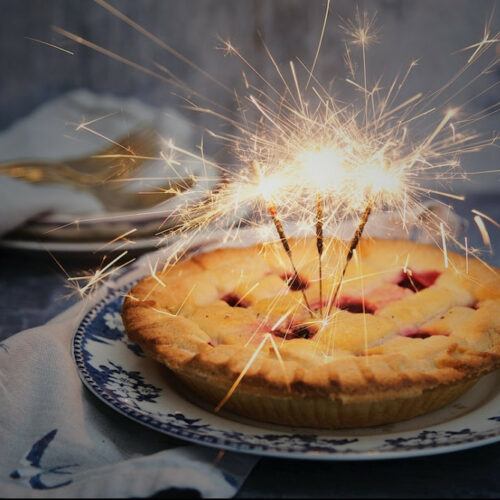
Double Pie Crust Recipe
Making a pie with a bottom and top crust? You could make two of our single-crust recipes. Or, just use this recipe to create a double flaky delight.
Ingredients
- 2 1/2 cups flour or pastry flour
- 1 1/4 tsp salt
- 1/4 cup shortening or add more butter
- 10 tbsp unsalted butter very cold; you may use vegan butter, if desired.
- 1 tbsp lemon juice or vinegar
- 8 tbsp water icy cold, 8-10 tbsp total; a bit less with pastry flour
Instructions
- Measure flour into a medium-sized bowl by carefully spooning into the cup and leveling each cupful. Be careful not to pack it down.
- Add salt to flour and whisk briskly to mix.
- Using a pastry cutter or a fork, cut in the shortening. Combine to create a mixture that resembles coarse sand.
- Cut the butter into very small cubes and add to the flour. Use the pastry cutter to combine into a crumbly mixture. Be careful not to over mix. It should have larger and a some smaller pebbles. If you over-mix, it will become more smooth, creating a tough, mealy crust that is not flaky.
- Mix the lemon juice with half the water and drizzle over the flour mixture. Gently toss to combine.
- Add remaining water, a little at a time, until it forms a chunky mass that holds together but is rather dry. Avoid adding too much water.
- Transfer the mixture to a piece of parchment paper. Press it into a rectangle and fold the dough into thirds. Spritz any dry areas with cold water. Flatten and fold again, repeating the process until all stray bits of dough have been incorporated. This creates a more flaky layers in you finished pie crust.
- Divide into two balls about the same size. Flatten each into a round disk no more than 1-inch thick. Wrap separately in plastic wrap or put in container with a lid. Chill for about 30 minutes
- Remove one crust from the refrigerator, unwrap, and roll into a circle larger than the size of your pan. For a 9-inch pie, you will need a 12-inch circle. Use extra flour to ensure it does not stick to your rolling mat or counter, also adding flour to your rolling pin.
- Spray your baking pan lightly with non-stick baking spray or lightly oil the bottom and sides.
- Put the crust into the pan, stretching it across the bottom and up the sides. An easy way to move your crust is to fold it into quarters, then gently lift into pan.
- Remove the second crust from the refrigerator and roll in the same way to create the top crust.
- Add filling, then place top crust on the pie.
- Trim crust edges using your kitchen scissors or pinch off. Crimp edges together using either your fork or your fingers to create a complete, attractive edge.
- For the flakiest crust, refrigerate your pie for about 30 minutes before baking.
- Just before baking, brush the crust with an eggwash, milk, or water. This step is optional, but makes a nice sheen to your crust.
- Before putting in the oven, cut a series of 3 to 4 slits in the top crust to allow steam to escape. Some bakers like to create a decorative design, rather than the parallel slits.
- Bake according to the directions for your pie. Use foil or pie edge covers to prevent the edges from burning.